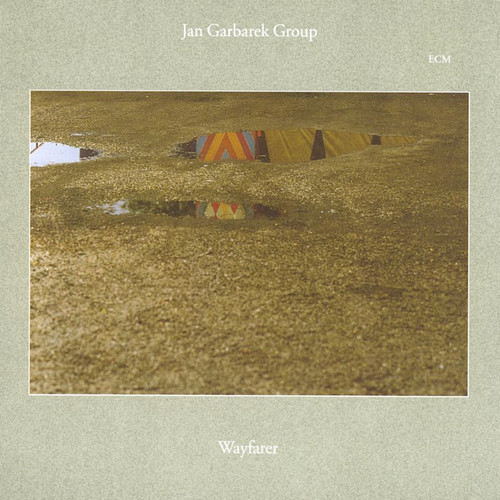Twelve Moons was Jan Garbarek’s 20th album as a leader for ECM. It also happened to be the 500th ECM production. The figures say something about the value of endurance. Back at the beginning of this story George Russell claimed that Jan Garbarek would come to be regarded as the most important European improvising musician since Django Reinhardt. A remark that smacked of hyperbole at the time now seems credible.
There are very few European improvisors who can be said to have transcended their original influences and made a music that reflects their own life, their own experiences ("If you don't live it, it won't come out the horn" - C. Parker), but Garbarek is unquestionably one of them. Lessons learned from a wide range of role models - Coltrane, Ayler, Pharoah Sanders, Dexter Gordon, Ben Webster - have been completely integrated in a conception that is in many particulars specifically Norwegian yet is also universal, continually uncovering correspondences with the folk musics of the entire globe. "You might say that I live in a spiritual neighbourhood that is scattered geographically around the world." Thus Garbarek is equipped to move easily from, say, jazz ballads with Miroslav Vitous (Star, Atmos) to North Indian classical music, interacting with singer Ustad Fateh Ali Khan and his group on Ragas And Sagas. This is one aspect of the saxophonist's work. Along the way, working on his own projects, he has also learned much about the dynamics of band leadership, and how to staff his groups with provocative combinations of personnel, sparking new music by bringing together players from quite different cultures.
Twelve Moons was the first Garbarek Group record after 1990's I Took Up The Runes, and in the interim there had been one fundamental change in the line-up, with Marilyn Mazur replacing Nana Vasconcelos. The Danish percussionist, who joined Garbarek's group after leaving Miles Davis's, is less of a "colouristic" player than her predecessor. She stays closer to the heart of the rhythm, working closely with Parisian drummer Manu Katché to build lithe, limber grooves that the leader can deploy as launch-pads for his impassioned flights on soprano and tenor.
Eberhard Weber had been with Jan since 1981's Paths, Prints, though their association goes back further, to Ralph Towner's 1974 "Solstice" band. Rainer Brüninghaus joined the Garbarek unit in time for the 1984 recording of It's OK To Listen To The Gray Voice, strengthening the German contingent in the line-up; Brüninghaus, of course, was a charter member of Weber's Colours band in the 1970s.
The thrust of the Garbarek Group's music is multi-directional. If the rhythms are frequently earthy and almost tribal in feel, the synthesizer soundscapes (created by Garbarek himself on the title track, and by Brüninghaus elsewhere) are richly-textured and hypermodern. The ensemble sound is uncategorizable: Garbarek rejected the "jazz" category for his own work long ago. ("When people ask me what kind of music I play, I have to say 'I don't know.'")
The continuing commitment to Norwegian source musics is one of Twelve Moons' sub-themes. "Arietta" is an adaptation of a piece by Edward Grieg, whose 150th birthday is celebrated in Norway this year. Grieg, of course, also used Norwegian folk music to spur his creative imagination. The local colour intensifies on Twelve Moons when singer Agnes Buen Garnås and Mari Boine come to the fore. Garngs, whose acclaimed Rosensfole helped build a new audience for Norwegian music, performs the traditional "Psalm", arranged here by Garbarek and sung after the manner of Sogn's Ragnar Vidal. Vocalist Mari Boine, born in the Arctic circle in the area that her Sami people refuse to call Lapland, sings her own "Darvanan". Although Boine had toured previously with Garbarek, this was her first ECM appearance. The influence of the Far North is also felt on "Huhai" which, despite its Latinate rhythms, also incorporates the traditional Sami joik "Oskar An'te."
Twelve Moons is unique in Garbarek's discography inasmuch as it is the first of his albums to look at his own past and review older material in a new light. There are two examples. "Brother Wind March" is an updating of "Brother Wind", which appeared on Legend Of The Seven Dreams. It is here transformed into an irresistibly propulsive piece and features high-flying, keening saxophone improvisations by the leader. "Witchi-Tai-To", written by the late Jim Pepper, was first recorded by Jan in 1973 on the album of the same name in the era of the Garbarek-Bobo Stenson Quartet. It has long been a concert favourite of Garbarek's and, since it seemed to fit the melodic flow of this album, was reworked to conclude this set. The new version has Manu Katché stressing the Native American rhythm of the piece, his darkly resonant tom-toms suggesting the ceremonial frame drum playing of the Plains Indians.
Tracklist:
Twelve Moons (7:35)
1.1 Part One: Winter-Summer
1.2 Part Two: Summer-Winter
2 Psalm 6:32
3 Brother Wind March 10:17
4 There Were Swallows ... 8:36
5 The Tall Tear Trees 5:45
6 Arietta 6:21
7 Gautes-Margjit 11:53
8 Darvánan 4:54
9 Huhai 7:29
10 Witchi-Tai-To 5:43
Bass – Eberhard Weber
Drums – Manu Katché
Keyboards – Rainer Brüninghaus
Percussion – Marilyn Mazur
Saxophone [Saxophones] – Jan Garbarek
Vocals [Vocal] – Agnes Buen Garnås, Mari Boine







